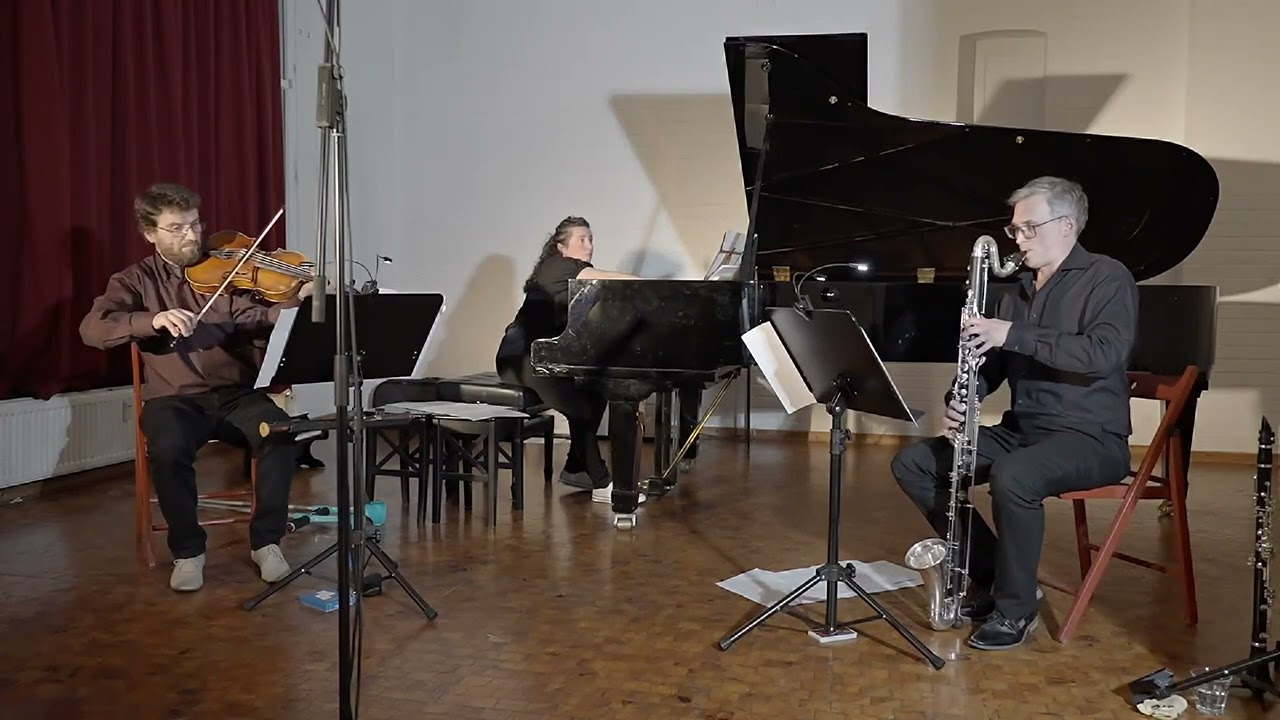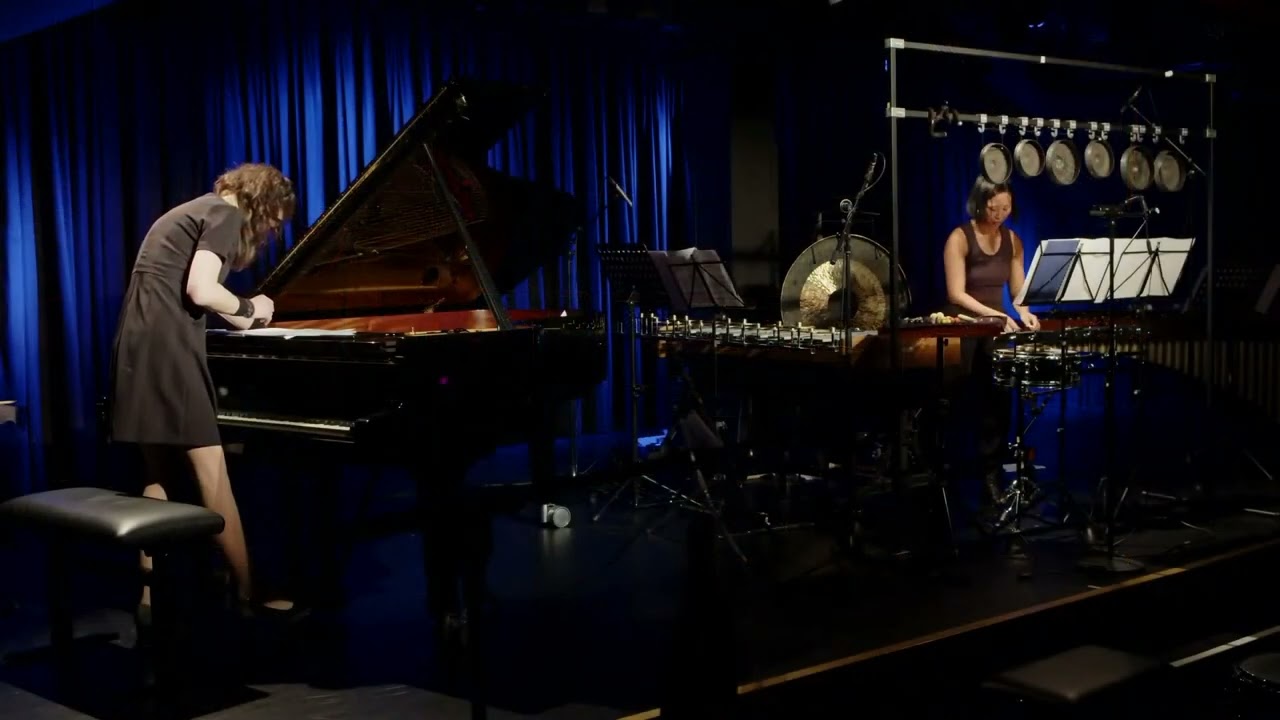Filterskizzen
für präpariertes Klavier solo for prepared piano solo
WP 19.09.2019, ausland, Berlin
The Filterskizzen is a cycle of five pieces for prepared piano created in 2019 and 2022. Each of the five Filterskizzen spans its own sonic microcosm. Just as in photography a black-and-white filter or a soft-focus filter influences the overall visual quality of an image, or in audio engineering the filtering of an audio signal with the help of an equaliser can change its overall tonal properties, so too the preparations of the piano act like a global filter. The integrity of the instrument is deconstructed, its sonority distorted and various individual aspects are greatly magnified in their importance and expressivity.
Some require the performer to have a virtuoso mastery of the keyboard in the classical sense, while others make it necessary to learn entirely new playing techniques. Together they form a cycle of pieces that are completely different in their sonority and expressivity, but which nevertheless create a dramaturgical arc with each other.
My greatest thanks go to Alba Gentili-Tedeschi, who, as an outstanding pianist extremely versed in both classical and contemporary repertoire, facilitated and accompanied the composition process.
Filterskizze I
The starting point was research into harmonics, which can be produced by tapping the corresponding vibration nodes on the low strings of the piano. Established for a long time in the contemporary piano repertoire, two aspects have always remained unsatisfactory to me: firstly, the difficulty for the player to find the right spot on the string reliably and quickly, and secondly – related to this – the impossibility to play fast or more complex musical phrases exclusively with harmonics.
After experimenting for a while, I developed what I call harmonics bars. These are thin wooden bars that are coated with adhesive rubber at the bottom and stick to the strings in such a way that they reliably produce the desired harmonics when struck normally on the keyboard. The sonic result is not exactly the same as with the hand-fingered harmonics, but they sound somewhat more subdued, drier, and more percussive. It is precisely from this characteristic that I derived the basic idea of Filterskizze I, which essentially plays with the development of repetitive rhythmic cells.
The bars are arranged in such a way that the resulting harmonics (as fifths, thirds, or sevenths) are almost all in the range of a fourth between g#3 and c#4. In addition, the strings in the middle register are damped, so that in this narrow tonal space each tone is present four times in different timbre and microtonal tuning. The composition gradually probes this tonal space with increasing complexity and intensity.
Filterskizze II
More than ten years ago, a fellow percussionist drew my attention to the possibility of using small vibrators, as they are known in the erotic field, as sound generators for percussion cymbals. The transfer to the inner piano was obvious, but first several technical problems had to be solved in order to get sufficient control over the vibrators and to avoid damaging the instrument. I found the solution in self-made shells consisting of a rubber ring with a bottom made of various thin materials.
The shells allow any number of vibrators (in practice I use up to six) to be placed in the piano, whereby the vibrators are fixed to an approximately determined interval range in which they can move freely – and thus somewhat unpredictably.
Because of the inherent indeterminacy of the vibrators, which, in addition to their fascinating tonal potential, is what makes them so appealing, I have chosen a predominantly graphic form of notation for this piece, illustrating the positions and movements of the vibrators in the piano.
Filterskizze III
Plucking the strings with the fingernail or a guitar pick is another classical playing technique of the contemporary piano. I aimed to explore the tonal possibilities of this technique as far as possible and to create a very strongly differentiated sound world within this narrow restriction.
Globally, the music moves in one long movement from the highest to the lowest register of the piano, with various uses of the plectrum coming into play: always present is the plucking of the strings behind or in front of the mutes (the latter results in a more metallic sound), which can be replaced by tapping in the first sections.
In addition, glissandi occur in all registers and dynamics – in the middle register in combination with the mute tapping of chords on the keyboard, whereby these chords emerge quasi as an echo from a rather dry glissando. Glissandi are also used behind the tailpieces, producing an irrational, shimmering sound.
A completely newly developed playing technique is the slow movement of the pick with high pressure on a low bass string, causing the pick to jump from groove to groove of the string and producing a perforated, aggressive sound.
Filterskizze IV
Filterskizze IV is inspired by Alvin Lucier’s “Music for piano with magnetic strings” from 1995. Lucier’s score consists of a brief page of text in which he instructs the player to place four to five e-bows on the strings of the piano and to move them gradually. There is no further information about the duration or the sounds. So, the desire grew in me to compose a piece for e-bows in which the sounds and their sequence are composed, coupled with the search for the greatest possible sound. Since the e-bows can only be placed in the middle register of the piano and always require three strings, of which, however, only the middle one produces a sound, it takes some planning and calculation to place more than five E-Bows sensibly and make them mobile. The eight e-bows used in the Filterskizze IV, in my opinion, represent the maximum number of what is possible.
Starting from one tone, to which the fifth is added, a kind of overtone spectrum is built up which, of course, is not free of beatings due to the tempered tuning, but on the contrary, contains extremely interesting and welcome pulsations. Once the full eight-tone spectrum has been built up, it is transformed in such a way that a new chord constructed by transposing a three-tone cell around a central axis emerges. This new chord decays in a motion opposite to that of the beginning until, again, a pure fifth (but now a third higher than the beginning) remains and fades away.
Filterskizze V
Filterskizze V certainly has the most traditional notation of all the pieces in the cycle, and indeed it could be played to a large extent without preparations. What is envisaged, however, is the preparation of the strings with small magnetic cubes, which are placed in the middle register on two of the three strings that are struck with the same hammer. The prepared strings are slightly microtonally out of tune and have a more metallic character, whereas the unprepared string retains its original tuning and timbre.
This mixture results in a strongly altered overall sound reminiscent of traditional zither instruments but still allows a very differentiated harmonic-melodic treatment of the instrument. The relatively complex musical structure is derived from this sound characteristic and plays above all with the variable density and mobility of the polyphonic or homophonic movement.
In the bass register, larger magnetic cubes are placed on vibration nodes of harmonics, creating a complex, strongly microtonal sound.
Filterskizzen1

